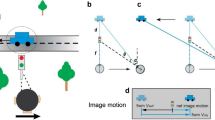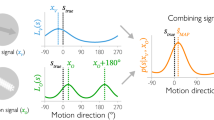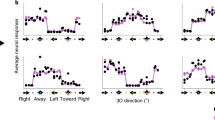Abstract
The eyes receive slightly different views of the world, and the differences between their images (binocular disparity) are used to see depth. Several authors have suggested how the brain could exploit this information for three-dimensional (3D) motion perception, but here we consider a simpler strategy. Visual direction is the angle between the direction of an object and the direction that an observer faces. Here we describe human behavioral experiments in which observers use visual direction, rather than binocular information, to estimate an object's 3D motion even though this causes them to make systematic errors. This suggests that recent models of binocular 3D motion perception may not reflect the strategies that human observers actually use.
This is a preview of subscription content, access via your institution
Access options
Subscribe to this journal
Receive 12 print issues and online access
$209.00 per year
only $17.42 per issue
Buy this article
- Purchase on Springer Link
- Instant access to full article PDF
Prices may be subject to local taxes which are calculated during checkout






Similar content being viewed by others
References
Westheimer, G. The spatial sense of the eye. Invest. Ophthalmol. Vis. Sci 18, 893–912 (1979).
Howard, I.P. & Rogers, B.J. Depth Perception. Seeing in Depth Vol. 2 (I. Porteous, Toronto, 2002).
Cumming, B.G. & Parker, A.J. Binocular mechanisms for detecting motion-in-depth. Vision Res. 34, 483–495 (1994).
Regan, D. Binocular correlates of the direction of motion in depth. Vision Res. 33, 2359–2360 (1993).
Brooks, K.R. Interocular velocity difference contributes to stereomotion speed perception. J. Vis. 2, 218–231 (2002).
Harris, J.M. & Dean, P.J.A. Accuracy and precision of binocular 3D motion perception. J. Exp. Psych. Hum. Perc. Perf. 29, 869–881 (2003).
Rushton, S.K., Harris, J.M., Lloyd, M.R. & Wann, J.P. Guidance of locomotion on foot uses perceived target location rather than optic flow. Curr. Biol. 8, 1191–1194 (1998).
Wilkie, R.M. & Wann, J.P. Driving as night falls: the contribution of retinal flow and visual direction to the control of steering. Curr. Biol. 12, 2014–2017 (2002).
Harris, J.M. & Bonas, W. Optic flow and scene structure do not always contribute to the control of human walking. Vision Res. 42, 1619–1626 (2002).
Fajen, B.R. & Warren, W.H. Visual guidance of intercepting a moving target on foot. Perception 33, 689–715 (2004).
McKee, S.P. & Welch, L. The precision of size constancy. Vision Res. 32, 1447–1460 (1992).
Foley, J.M. Binocular distance perception. Psychol. Rev. 87, 411–434 (1980).
Beverley, K.I. & Regan, D. The relation between discrimination and sensitivity in the perception of motion in depth. J. Physiol. (Lond.) 249, 387–398 (1975).
Wann, J.P. & Swapp, D.K. Why you should look where you are going. Nat. Neurosci. 3, 647–648 (2000).
Wann, J. & Land, M. Steering with or without the flow: is the retrieval of heading necessary? Trends Cogn. Sci. 4, 319–324 (2000).
Chardenon, A., Montagne, G., Laurent, M. & Bootsma, R.J. The perceptual control of goal-directed locomotion: a common control architecture for interception and navigation? Exp. Brain Res. 158, 100–108 (2004).
Peper, L., Bootsma, R.J., Mestre, D.R. & Bakker, F.C. Catching balls: how to get the hand to the right place at the right time. J. Exp. Psych. Hum. Perc. Perf. 20, 591–612 (1994).
Welchman, A.E., Tuck, V.L. & Harris, J.M. Human observers are biased in judging the angular approach of a projectile. Vision Res. 44, 2027–2042 (2004).
Acknowledgements
We would like to thank P. Dean for collecting some of the data presented here. The work was funded by an Engineering and Physical Sciences Research Council project grant and an EPSRC Advanced Fellowship to J.M.H.
Author information
Authors and Affiliations
Corresponding author
Ethics declarations
Competing interests
The authors declare no competing financial interests.
Supplementary information
Supplementary Note 1
Control observers on original task. (PDF 49 kb)
Supplementary Note 2
Control experiment: trajectory discrimination. (PDF 193 kb)
Supplementary Note 3
Individual observer data and predictions. (PDF 107 kb)
Supplementary Note 4
Real 3D motion, target moves along track. (PDF 58 kb)
Rights and permissions
About this article
Cite this article
Harris, J., Drga, V. Using visual direction in three-dimensional motion perception. Nat Neurosci 8, 229–233 (2005). https://doi.org/10.1038/nn1389
Received:
Accepted:
Published:
Issue Date:
DOI: https://doi.org/10.1038/nn1389
This article is cited by
-
Use of cues in virtual reality depends on visual feedback
Scientific Reports (2017)
-
A study on approaching motion perception in periphery with binocular viewing: Visibility is increased in the absence of one eye’s information
Optical Review (2009)
-
Visuomotor transformation for interception: catching while fixating
Experimental Brain Research (2009)
-
Manual tracking in three dimensions
Experimental Brain Research (2006)



